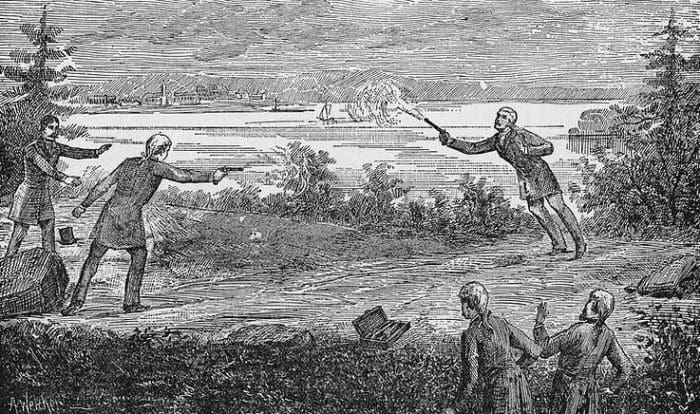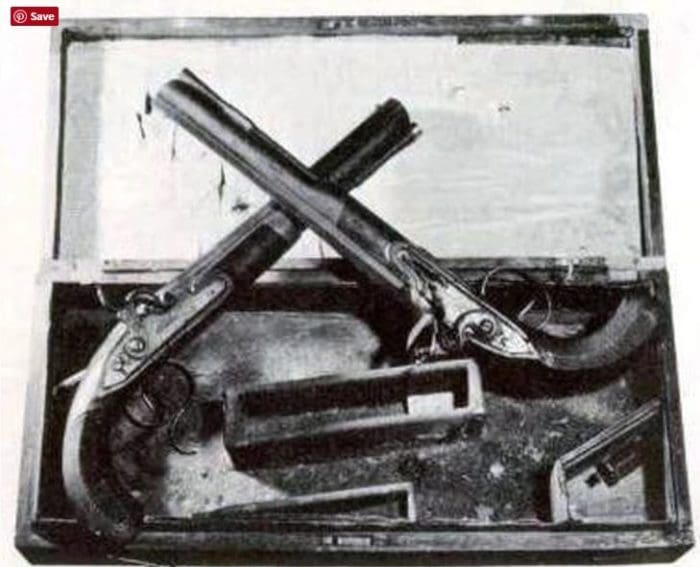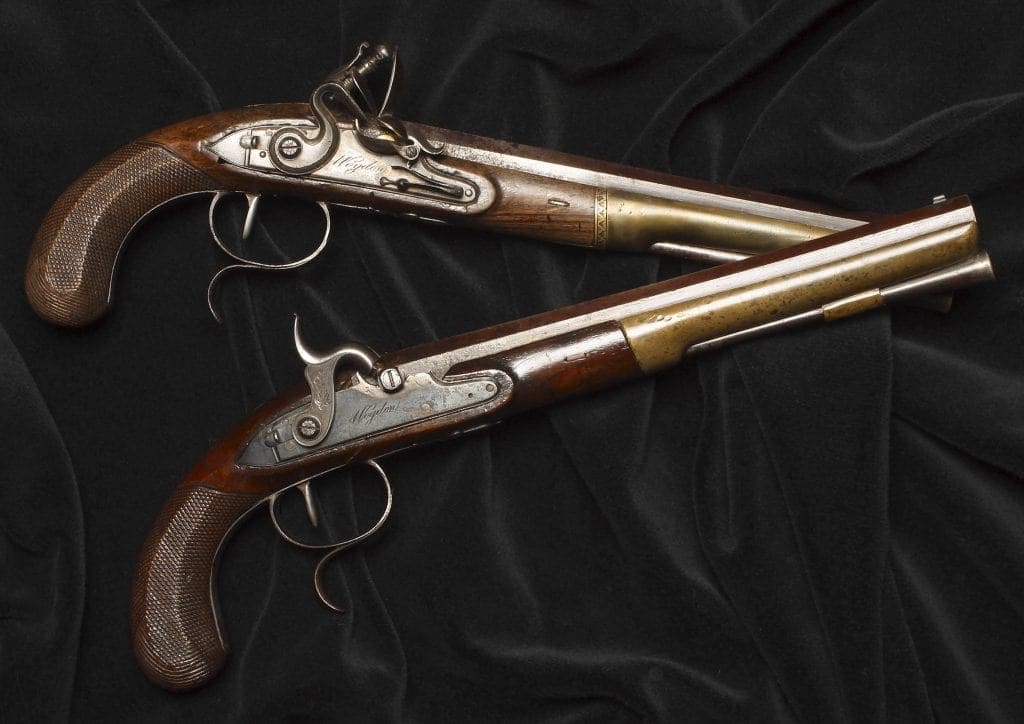Perhaps the most famous duel of all time occurred between former Secretary of the Treasury and retired two-star Army general Alexander Hamilton and the then-current Vice President Aaron Burr.

The Albany Register published a letter believed to have been written by Hamilton in which Burr was referred to as “despicable.” Burr took offense and challenged Hamilton to a duel as a result of this perceived slight of his honor.
Before getting too far ahead of the story, we have to go back to Europe for the birth of Robert Wogdon in 1737. Apprenticed to an Irish gunsmith at the age of 11, he was perfecting his craft under his own name by the age of 27.
By the time Hamilton and Burr drew their pistols against each other in the early part of the 19th century, Wogdon had just begun to enjoy his retirement, having become the most recognized name in the gunsmithing world when it came to duelling pistols.
In 1797, Alexander Hamilton’s brother-in-law, John Baker Church, had obtained an exquisite pair of custom-made dueling pistols made by Wogdon. The guns had several special features, including heavy brass forends for steadier aim and both front and rear sights for a more accurate shot.
Gathered at Weehawken, New Jersey, on July 11, 1804, Hamilton and Burr prepared for the duel. Hamilton fired the first shot; he missed Burr and struck a tree near him. (There is much debate surrounding whether or not he missed on purpose.) Burr then fired, hitting Hamilton in the lower abdomen with a .54-caliber lead ball.
Hamilton died the following day in New York, aged either 47 or 49, based on varied accounts of the year of his birth. Burr was charged with murder, but the charges were dropped. He finished his term as Vice President in 1805 and lived to be 80, dying in 1836.

A photo believed to date to 1904 shows the pistols in their current configuration – one flintlock and one percussion. Thus, that is how they appeared when purchased by Chase Manhattan Bank in 1930. The guns are permanently displayed there, but they are currently on display(until September 16, 2018) at the National Postal Museum in Washington, DC.
Why there? Hamilton played a role in establishing the US Postal Service.
Logan Metesh is a firearms historian and consultant who runs High Caliber History LLC. Click here for a free 3-page download with tips about caring for your antique and collectible firearms.




“People think I’m Aaron Burr the way I’m dropping Hamitons”
Alexander Hamilton is one of the great villains of American history. That man caused enormous harm to this country. He helped lead us into debt slavery.
It’s too bad this duel didn’t happen a couple decades earlier.
+1
Balderdash
He actually lead the U.S. out of 43 million dollars of debt. He did quite the opposite of what you’re saying.
Dear Antifederalist—you exhibit a lack of knowledge of basic finance–and of history–Hamilton ,under Washington, drew up standards for the banking system to protect borrowers–he conceived of things like port of entry regulations, taxing rules, the structure of training of the armed forces Etc. Etc.—you must remember that none of these functions of government existed and the new republic had to create a whole government under the constitution–we created a completely new form of government that existed nowhere else in the world at any time—-have you read ANY books on the revolution and the establishment of our nation–or are you a creature of the internet– hh
A nasty ole GUN inside a “postal facility”? Didn’t someone ready the sign on the taxpayer’s door?
Thank god we have become to civilized to shoot at one another over petty arguments. They were knuckle dragging savages back in the day. Just ask the British.
It would save so much taxpayer $$$ and make for a much politer society if we allowed for duels to return… Barbarians tend to be polite to eachother, one splits the others skull with an axe.
We could use some savagery in this country again to combat the beta male epidemic.
Interesting dueling pistols by Wogdon. I’ve often wondered why only one (and not the pair) was converted from flintlock to percussion. I also wonder whether these pistols were smoothbore (as most were) or rifled, or had bores rifled with “scratch rifling” to within about an inch of the muzzle, so the rifling couldn’t be seen and the illusion of being smoothbores was maintained, and thus preserve the image of gentlemanly fair play under the Code Duello and so forth. Does anybody know? The slightly later (1800-1820 period) English dueling pistols (by Manton, Durs Egg and others) I’ve examined at antique gun shows have been of the highest quality, and mostly all smoothbores.
Why would only one of the guns be converted to percussion?
It could be any one of several reasons:
– the job on the first pistol showed the then-owner that it wasn’t a smart thing to do, so he didn’t have it done to the second pistol
– the owner died, or for some other reason, didn’t pay the gunsmith for the first conversion
– or it could be that the owner wanted to shoot only one particular pistol, and not the other.
People come to gunsmiths with really odd requests all the time.
During the Civil War, one pistol was converted to percussion.
“After the duel, the pistols were returned to Church and subsequently passed down through the family—never to be fired again. During the Civil War era, one of the pistol’s flintlocks was switched out for a cap lock in an effort to modernize them.”
https://www.popularmechanics.com/military/weapons/a21083805/hamilton-dueling-pistols/
“…in an effort to modernize them.”
I hope they got dick cancer.
People sometimes wonder why I spend so much time asking customers with possibly collectable guns “Do you really want to do this?”
Well, in the early 19th century, the family probably didn’t think those pistols would be all that significant.
100 years later, well beyond the perspicacity of the early members of the family, these are now national treasures with huge historical significance.
Isn’t it obvious? When dueling, I will give the flintlock to my opponent (the rat-bastard).
Hamilton fired first because the pistols had hair triggers. They were measured for an old Guns & Ammo article more than fifty years ago. They broke at ounces, not pounds. Weighted forends and sights we’re not used on true duelling pistols. The duel consisted of the countdown and pace, the turn and fire. Aiming was never a part of a legitimate duel. Hamilton’s Seconds knew this which is why they did not immediately shoot Burr down as frequently happened in a botched duel such as this. As the old gunfighter said, “…as time passes no one will remember the guns, calibers or tactics used…just who won and who died.” Revisionism will be the end of us all. Orwell, “… whoever controls the past controls the future.” If you know parts of the past, preserve them. It will be the most important thing you can ever pass on to posterity. 30
“The Wogdon duelling pistols were the property of Hamilton’s brother in law, John Barker Church, who was a business associate of both men. The pistols, commissioned by Church in London, figure prominently in several duels – one between Church and Burr in 1799 in which neither man was injured, and one involving Hamilton’s son Phillip who died in an 1801 duel. They were almost used in a duel that would have taken place between James Monroe and Hamilton, in which Monroe shouts to Church, “I am ready, get your pistols!” but later Burr himself intervenes describing the two men as “childish.”
After the infamous Hamilton-Burr duel, the pistols were used in the Civil War, and then in 1930 are purchased by Chase Bank, now JP Morgan Chase Bank, the descendent of Burr’s company, the Manhattan Company, founded as a water service delivery company with exclusive rights to serve New York City.”
In 1974
“In 1974, when the pistols were disassembled for study and to create replicas in honor of 1976’s bicentennial, the supposedly “startling discovery” of the hair trigger grew into a the idea that Hamilton actually had a secret advantage. But other experts dismissed the idea as insignificant. “It wasn’t really new [information] to anyone who knew about these particular [types of] pistols,” Palley says. “Hair triggers were not all that uncommon…at that time.”
“Even on his deathbed, Hamilton reportedly admitted to not setting the hair trigger, providing compelling evidence that the former Treasury secretary didn’t have any deadly intentions that July day.
“Hamilton never intended to shoot [Burr],” Palley says. “If he had set the hair trigger, we would have probably gotten off a better shot.”
https://www.popularmechanics.com/military/weapons/a21083805/hamilton-dueling-pistols/
https://untappedcities.com/2016/02/16/alexander-hamilton-and-aaron-burrs-dueling-pistols-are-in-the-jp-morgan-chase-headquarters-in-nyc/
“After the infamous Hamilton-Burr duel, the pistols were used in the Civil War,…”
OK, that may be a clue –
Perhaps one was converted to percussion to make it a reliable everyday carry piece in battle?
If politicians still had a duel to settle arguments, we wouldn’t need term limits.
gawd. we’d be having elections every week. and pretty soon through natural selection congress would be completely made up of force recon marines and army snipers. and our primaries would take place at the shooting range.
You say that as if it would be a problem…
I think dueling should be brought back.
It would certainly thin out the ranks of politicians, media pinheads and intellectuals with too much access to word processors, and that would be a very good thing for civilization as a whole.
Believe it or not but dueling is still legal in Paraguay provided both of the duelists are signed up blood donors. No I’m not making this up.
Sadly, those are the very people who would never accept the challenge.
You have my vote. I’ve said they should bring back dueling for decades now. If one fella wants to kill another, and the other agrees to fight, how is that any of my(or the State, or anyone’s) business? How is it much different than a boxing match? Boxers get killed in the ring, but the State doesn’t interfere in that. Why not? Only because there is money involved?
I can fix that. Bring back dueling, and hold it in sports arenas. Charge people admission and open betting windows. So long as there is violence involved, lots of people will be glad to pony up.
A tradition that should return !
Doesn’t the challenged get to pick weapons to be used in duel?
Perhaps it should be brought back..just a thought.
6.5 Creedmore at 1500 yards? Live on ESPN?
I would cite Andrew Jackson, but that was before his Presidency.
“Gathered at Weehawken, New Jersey, on July 11, 1804, Hamilton and Burr prepared for the duel.”
I’ve been to Weehawken. The only good thing I can say about it is that it’s not Hackensack.
I expect the neighborhood has deteriorated since then.
The entire state has gone to hell in the last 40 years – not that parts of it weren’t already dungheaps (Newark, the Oranges, Edison, Hoboken, etc).
Dueling was against the law then but, like now, if you were rich and/or politically powerful it was seldom prosecuted.
A 54 caliber ball the the gut would not be a pleasant way to die, especially back then.
Hamilton created the coast guard too. A remarkable man if there ever was one.
The first boats were civilian owned armed with a small cannon. The 2A on the high seas!
Remarkable for all the wrong reasons
There’s a great chapter in the book Founding Brothers on the Hamilton Burr duel. In most cases, the duel was about one’s honor and not the infliction of violence. Some historians believe that despite his questionable reputation, Burr did not actually mean to kill or even wound Hamilton. He probably intended to fire near him and was more accurate than he thought. That’s at least one theory anyways. Truly a fascinating time in our history.
Pistols for two…coffee for one.
A fascinating fictional account of a duel may be found in Patrick O’Brian’s “H.M.S. Surprise”, the third entry in the superb Aubrey/Maturin canon.
Dr. Maturin fights Richard Canning in Calcutta.
Burr did us all a favor. Hamilton would have gone on to ruin the country even more.
I totally support bringing back dueling and public executions. It would make us more polite in public and private.
A few comments based on collecting duelling pistols for 60 years, starting with tatty examples in college days and gradually acquiring better examples. I now have a dozen representative cased pairs and several single pistols. Also, I must have handled a hundred or so pairs at dealers over the years.
The pistols, which are marked “Wogdon,” on the locks and top flat were actually manufactured before 1797, since Wogdon joined with Barton in 1794 to form Wogdon and Barton. Also, they were originally fully stocked in walnut, and the bronze {not brass} crude forestocks are later additions., since Wogdon would never have butchered his pistols in that manner. They were probably fitted to make the pistols muzzle-heavy, which was supposed to be an advantage for marksmen dwelling on an aim. This is in contrast to early duelling pistols, which were intended for snap-shooting, and functioned as an extension of the arm, particularly so for Wogdon pistols.
Regarding “sights”: I have never encountered a true duelling pistol that did not have sights at both the front and rear of the barrel. This includes the earliest of true duelling pistols, dating from 1775-ish.
“Set triggers: By the 1790’s it would be unusual to encounter duelling pistols that did not have set triggers. I have a cased set of Wogdon duellers from about 1780-85, and also five single Wogdon duelling pistols. All have set triggers. One interesting fact here though is that the Wogdon pistols do not have the small visible adjustment screw located externally, next to the trigger, that is obvious proof that it is a “set trigger.” Some makers located the adjustment externally to the lock, others internally. Overall, by 1790-1800, if you were familiar with duelling pistols you would assume that they had set triggers unless they were of very early manufacture. If however duelling pistols were not your “scene,” there was no visible indication that the Wogdons had set triggers.
Sadly, it was a case of “Pistols for two, coffee for one.”